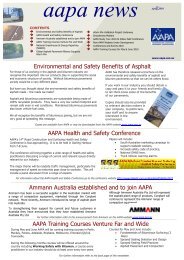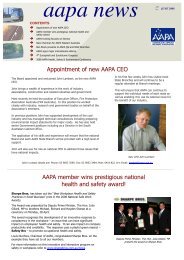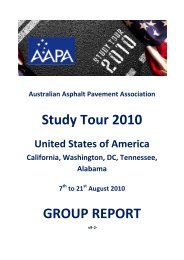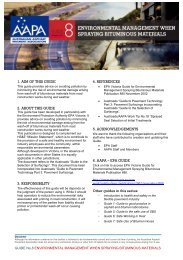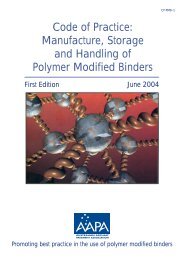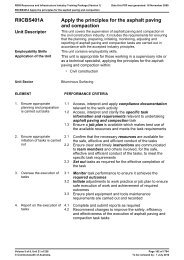Asphalt Review - Volume 29 Number 2 (June / July 2010)
Asphalt Review - Volume 29 Number 2 (June / July 2010)
Asphalt Review - Volume 29 Number 2 (June / July 2010)
You also want an ePaper? Increase the reach of your titles
YUMPU automatically turns print PDFs into web optimized ePapers that Google loves.
ASPHALT REVIEW<br />
research and quality control testing has<br />
been carried out in association with this<br />
work, with considerable successes being<br />
obtained.<br />
4. Benefits of Half-Warm Mixes<br />
The two main benefits of Half-Warm<br />
asphalt mixes are:<br />
1. Reduction in greenhouse gas<br />
emissions; and<br />
2. Improvement in field crew health and<br />
safety.<br />
A closer examination of the technology<br />
reveals additional benefits for both<br />
producers and purchasers of Half-Warm<br />
asphalt mixes.<br />
4.1 For the producer<br />
Producing mix at a lower temperature<br />
means that the differential between<br />
ambient and mix temperature is reduced.<br />
This means that the Half-Warm asphalt<br />
mix will cool more slowly compared<br />
with hot mix asphalts. A slower rate of<br />
cooling allows longer cartage distances,<br />
extended workability time in the field<br />
and the ability to place and compact in<br />
cooler conditions.<br />
Because the Half-Warm asphalt cools<br />
more slowly, the formation of a chilled<br />
‘crust” on the surface of payloads does not<br />
form to the same degree. Another benefit<br />
of the Half-Warm asphalt technology is<br />
cleaner truck decks and hand tools.<br />
4.2 For the Client<br />
Conventional hot-mix asphalts are<br />
produced at around 165° C so that<br />
the viscosity of the bitumen binder is<br />
lowered enough to permit adequate<br />
workability of the mix. A negative effect<br />
of this high production temperature is<br />
the aging of the bitumen due to reaction<br />
with atmospheric oxygen. This is a well<br />
known phenomenon and is controlled<br />
by including aging tests in bitumen<br />
specifications<br />
The chemical additives in the Half-<br />
Warm process contain active adhesion<br />
promoters. Thus the risk of water<br />
damage in the asphalt pavement is<br />
reduced or eliminated. This use of<br />
adhesion promoters is contrasted with<br />
some Warm Mix systems that depend<br />
on the use of water, potentially trapping<br />
water in the mix and degrading longterm<br />
performance. The Half-Warm<br />
process provides for long-term adhesion<br />
of bitumen to the aggregate by including<br />
active chemistry in the additive<br />
chemicals.<br />
The reduction in temperature<br />
differential between the half-Warm<br />
asphalt and ambient temperatures,<br />
the extended workability and the<br />
minimisation of “crust” formation means<br />
that compaction is more readily achieved<br />
in the field minimising the risk of rutting,<br />
permeability and binder oxidation.<br />
The Half-Warm asphalt process is<br />
a means for the production of asphalt<br />
paving mixes. The same material is being<br />
manufactured and placed; it’s only the<br />
manufacturing process that has changed.<br />
5. New Zealand Experience with<br />
Half-Warm Mixes<br />
In 2005, Fulton Hogan began assessing<br />
warm mix and half-warm mix<br />
technologies available around the world,<br />
and selected the low emissions asphalt<br />
(LEA) process to implement in the<br />
company’s New Zealand asphalt plants.<br />
Following laboratory development and<br />
early pilot trials constructed on a haul<br />
road within one of Fulton Hogan’s<br />
quarries in Christchurch, some high<br />
profile/high-demand sites were paved:<br />
1. Buckley’s Road, Christchurch,<br />
December 2007<br />
2. Montreal Street, Christchurch,<br />
March/April 2008;<br />
3. Christchurch International Airport<br />
taxiway, February 2008.<br />
To date the performance of all the<br />
trials has been exemplary. Cores were<br />
taken of the trial sections in August<br />
2008 (4 months after they were laid),<br />
and tested in Fulton Hogan’s laboratory<br />
wheeltracking device. The AC14 initially<br />
had a higher rate of rut development<br />
compared with the CoolPave, but after<br />
10,000 passes they had similar rut<br />
depths.<br />
Our experience to date is that the<br />
Half-Warm process allows asphalt<br />
pavements to be placed at a quality<br />
equal to, or better than, conventional<br />
hot mix asphalt pavements.<br />
Fulton Hogan has produced Coolpave<br />
in 5 of its 14 fixed plants, all of which<br />
are continuous drum plants.<br />
Fulton Hogan has produced<br />
approximately 6000 tonnes of Coolpave,<br />
mostly a standard 14 mm dense mix.<br />
Small runs of 7mm and 10 mm mix<br />
have been produced for hand work trials<br />
which worked successfully.<br />
Mixes have been laid to date on minor<br />
city streets, multi-lane city arterials,<br />
airport taxiways and factory yards/<br />
carparks.<br />
Compaction results in the field show<br />
that Coolpave compacts similar to hot<br />
mix, and the workable time and time to<br />
compact increases using Coolpave.<br />
Minimal laboratory-based performance<br />
testing has been conducted, although<br />
one wheel tracking test showed that after<br />
10,000 passes the AC14 Coolpave had<br />
almost exactly the same degree of rutting<br />
as hot mix AC14. The Coolpave product<br />
reported total rutting equal to 96% of the<br />
hot mix value after 10,000 passes.<br />
6. Clients’ Perspectives<br />
6.1 Christchurch City<br />
Christchurch City Council leads and<br />
strongly supports local environmental<br />
initiatives in transportation and other<br />
fields – particularly where these initiatives<br />
may have benefits for the wider regional<br />
and national community.<br />
The production of standard asphalt<br />
has a high energy requirement due to<br />
the need for materials to be heated<br />
during production and the need for<br />
high temperatures to be maintained<br />
through to final placement. The high<br />
temperatures required to manufacture<br />
asphalt also result in high emissions<br />
to atmosphere as well as temperaturerelated<br />
safety issues for site staff and the<br />
public during the laying-down process.<br />
This initiative by Fulton Hogan meets<br />
council’s expectations for practical<br />
solutions to both environmental and<br />
safety issues. The material met initial<br />
trial requirements and meets all council<br />
asphalt test needs. The full scale trials at<br />
the two sites have to date demonstrated<br />
that material design, manufacture,<br />
cartage and laying methodologies are<br />
similar to standard asphalt; resulting in<br />
burner fuel savings during manufacture<br />
due to lower energy requirements,<br />
reduced emissions, easier achievement<br />
of density requirements when laying<br />
in cooler air temperatures and greater<br />
safety during placement.<br />
Council tendering and contract<br />
methodologies encourage innovation and<br />
Fulton Hogan’s proposal was developed<br />
within this framework. Council works<br />
with the local contracting industry to<br />
explore new initiatives. The local industry<br />
has demonstrated a willingness to work<br />
with council to meet both community<br />
and industry needs and has shown great<br />
passion in their endeavours.<br />
6.2 Christchurch International<br />
Airport<br />
Christchurch International Airport<br />
Limited (CIAL) has worked with Fulton<br />
Hogan for the last 18 years on Airfield<br />
Pavement Maintenance Works (APMW).<br />
In 2006, CIAL encouraged Fulton Hogan<br />
to undertake a process of innovation<br />
to reduce the total cost of ownership<br />
and reduce the carbon footprint in the<br />
delivery of the APMW programme. CIAL<br />
is a CarbonZero Airport, the first in the<br />
26 ROADS JUNE <strong>2010</strong>/JULY <strong>2010</strong>



